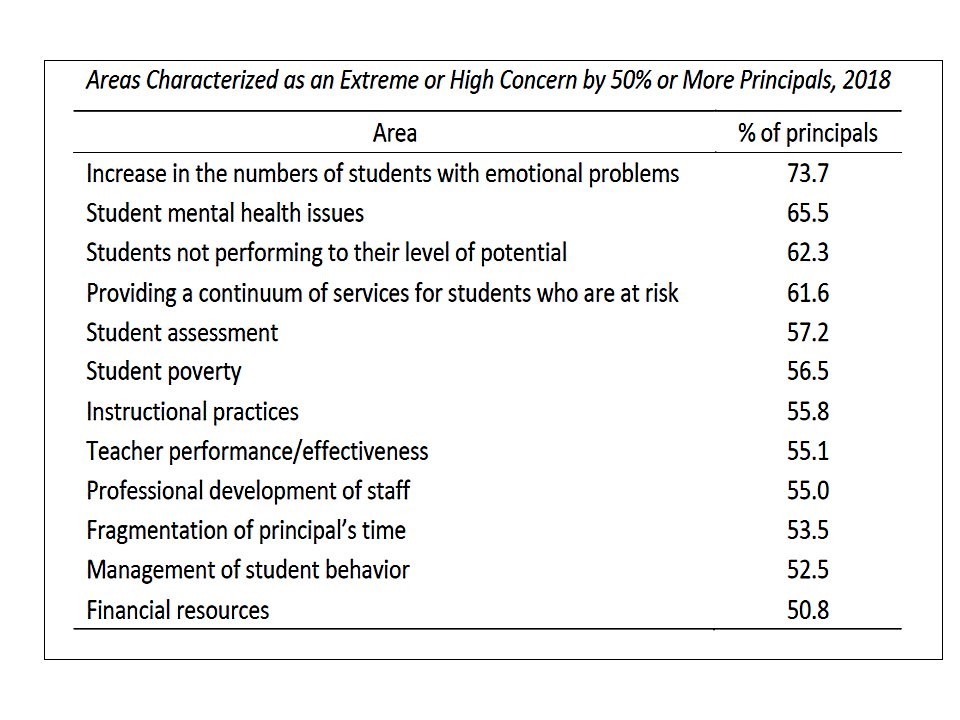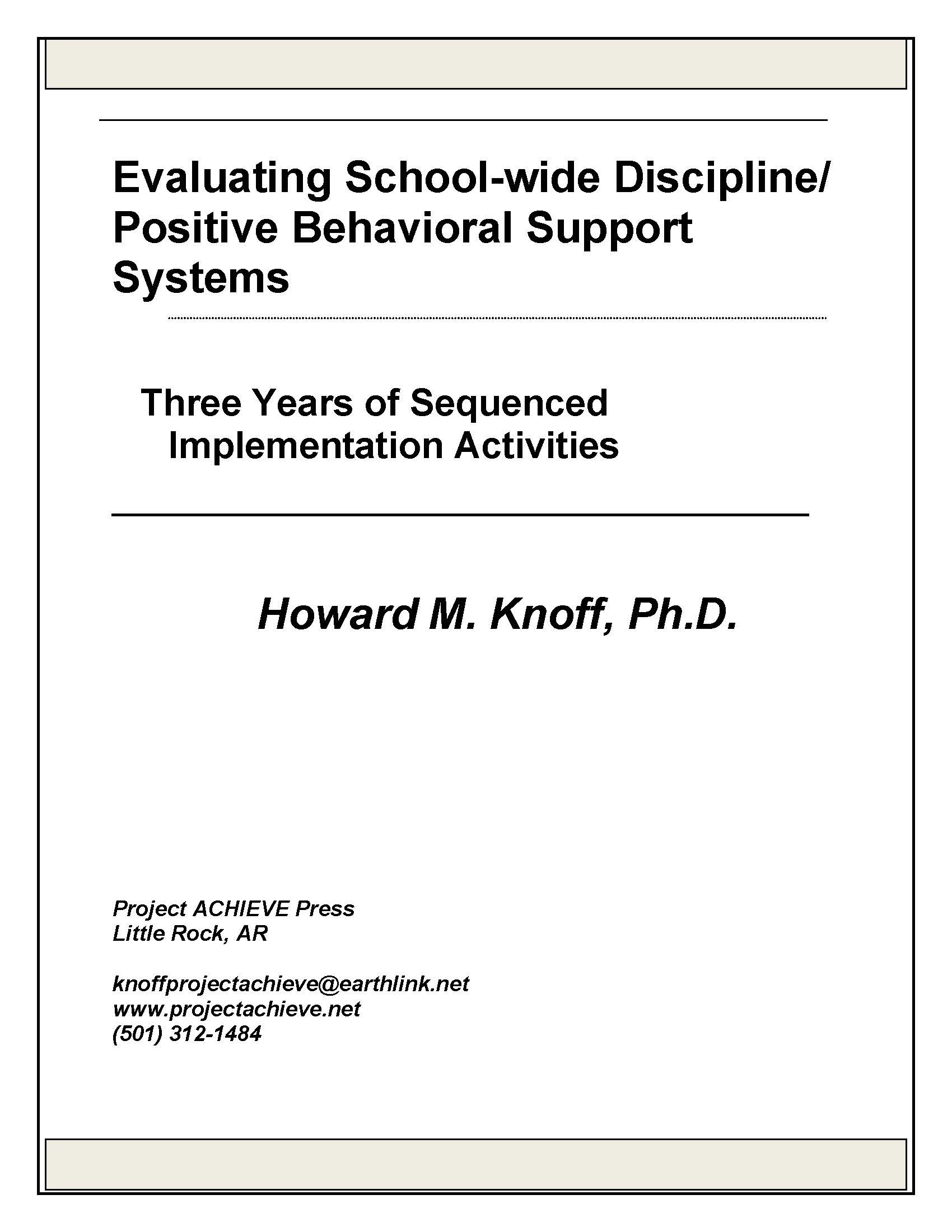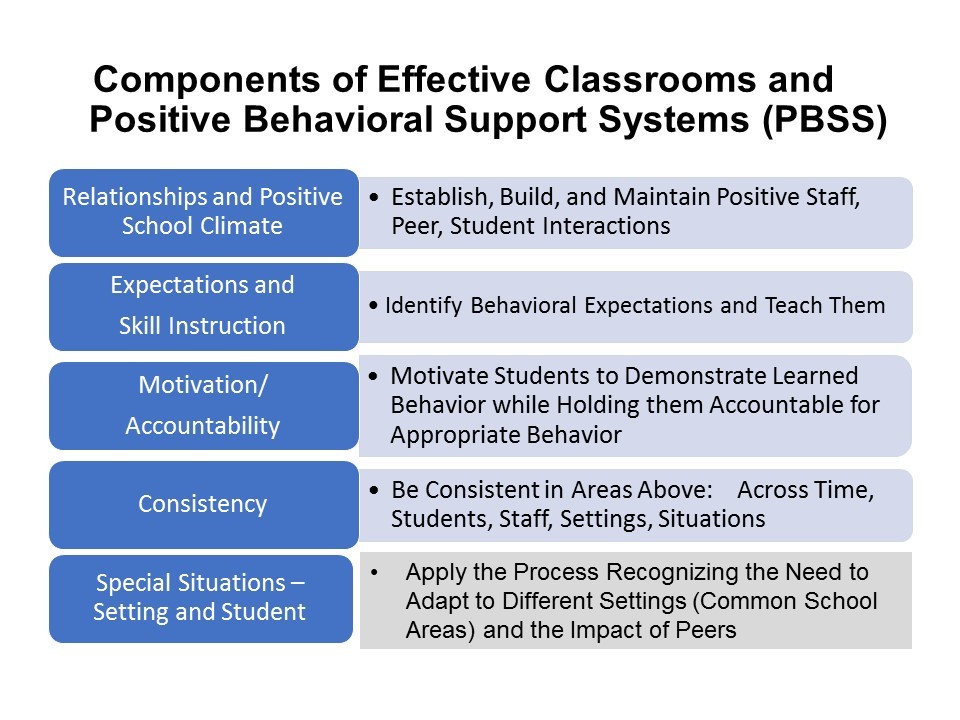The Solution? Project ACHIEVE’s Multi-Tiered, Evidence-Based Roadmap to Success
Dear Colleagues,
Introduction
While most students and staff are off on vacation and not thinking about homework and teaching, many administrators are still on the job. And without the daily focus on immediate tasks, to-do’s, and trouble spots, these administrators often use their summer “simmer” time thinking about ways to resolve their most pressing problems.
In order to gain some insight into these “problems,” the National Association of Elementary School Principals (NAESP) recently conducted its once-every-ten-year survey of a representative sample of elementary school principals across the country.
[CLICK HERE for the Report]
The most-relevant survey question here asked respondents to separately rate their concerns—along a five-point scale from “Extreme” to “None”—with over 20 different student-related areas.
The Table below identifies those areas where 50% or more of the principals rated their concerns at the top of the scale—as either “Extreme” or “High.” The NAESP synthesized a number of these items, as well as some additional highly-rated items from this question, and concluded that:
Students’ social, emotional, and behavioral status was “the top-ranked concern for 2018 responding principals. . . (including) addressing the increase of students with emotional problems. Among those issues identified were the management of student behavior, student mental health issues, absenteeism, lack of effective adult supervision at home, and student poverty. In contrast, none of the student-related issues were identified as a major concern in 2008.”
 _ _ _ _ _ _ _ _ _ _
_ _ _ _ _ _ _ _ _ _
Addressing Principals’ Most Pressing Concern:
Project ACHIEVE’s Evidence-Based, Multi-Tiered Social-Emotional Learning/Positive Behavioral Support System
In order to directly address the most-pressing concerns voiced in the NAESP survey, below is a description of Project ACHIEVE’s Social-Emotional Learning/Positive Behavioral Support System (SEL/PBSS). Project ACHIEVE’s SEL/PBSS is an evidence-based model (through the U.S. Office of the Substance Abuse and Mental Health Services Administration) that has been implemented in thousands of schools across the country with consistent and clearly documented student, staff, and school success.
An Overview of Project ACHIEVE
Project ACHIEVE is a comprehensive preschool through high school continuous improvement and school effectiveness program that has been implemented in urban, suburban, and rural districts across the country since 1990. Project ACHIEVE was recognized by the U.S. Department of Health & Human Service’s Substance Abuse and Mental Health Services Administration (SAMHSA) as an evidence-based model prevention program in 2000. Its effectiveness has also been recognized by the U.S. Department of Justice’s Office of Juvenile Justice and Delinquency Prevention (OJJDP, 2003); the Collaborative for Academic, Social, Emotional Learning (CASEL, 2002); and other national, regional, and state groups.
Project ACHIEVE is now listed on SAMHSA’s National Registry of Evidence-based Programs and Practices (NREPP), and its implementation blueprints, procedures, and strategies are embedded into its well-defined components that maximize school and district success across an assortment of ESEA/ESSA and IDEA-required outcomes.
Between 2003 and 2015, Project ACHIEVE was implemented on a statewide basis in Arkansas through the Arkansas Department of Education’s (ADE) State Improvement and State Personnel Development grants (SIG and SPDG, respectively). These grants were awarded to the ADE by the U.S. Office of Special Education Programs (OSEP).
Directed by the author, these grants resulted, during that time, in Project ACHIEVE being designated as the ADE’s primary school improvement model for all of the Focus schools in the state—through its successful ESEA Flexibility application with the U.S. Department of Education. Concurrently, Project ACHIEVE was used as the Department and state’s official PBIS and MTSS approaches.
_ _ _ _ _
Project ACHIEVE’s SEL/PBSS System
Because the same psychologically-based science of individual, group, and systems-level behavior, that targets and results in students’ social, emotional, behavioral, and mental health self-management, is at the foundation of its practices, Project ACHIEVE’s SEL/PBSS system addresses a host of proactive goals and problematic conditions in a unified and integrated way.
This means that districts and schools implement a single evidence-based model, rather than (a) multiple, potentially-competing (as well as time-consuming, exhausting, and expensive) unaligned programs, or (b) frameworks that lack sound science-to-practice implementation guidance, or that encourage people to “choose-your-own-strategies”—a recipe that often results in chasing symptoms and not real problems, or choosing activities by convenience and not causality.
As such, some of the most important areas addressed by Project ACHIEVE’s integrated, science-to-practice SEL/PBSS system are:
- School safety and prevention,
- Positive school culture and classroom climate,
- Classroom discipline and management,
- Student engagement and self-management,
- Social Skills training and teaching 21st Century SEL/Soft Skills
- Productive student interactions in cooperative and project-based groups,
- Student trauma and trauma-sensitive practices,
- Teasing and bullying,
- Harassment and physical aggression,
- Chronic student absences and school/class tardiness,
- Office discipline referrals and suspensions/expulsions,
- Disproportionality and retiring zero tolerance policies, and
- Preventing and responding to students’ mental health status and needs.
To accomplish this integration, Project ACHIEVE’s multi-tiered SEL/PBSS approach starts by helping teachers with classroom management, student engagement, and the development of an explicit student motivation and behavioral accountability matrix. Added to this is a social skills curriculum where teachers teach students, from preschool to high school, the interpersonal, social problem-solving, conflict prevention and resolution, and emotional control and coping skills that they need for individual, peer, classroom, and school success.
When students do not respond, need additional help, or require more strategic or intensive attention, the multi-tiered system uses data-based functional assessment approaches to determine the underlying causes of students’ challenges, and links the results to the implementation of relevant services, supports, strategies, and interventions. These are implemented along a continuum involving classroom-based consultation by related services staff (e.g., counselors, school psychologists, special education teachers, social workers) through individual cognitive-behavior therapy by school-based mental health professions.
This entire system involves a whole school approach that focuses on positive, safe, proactive, supportive, and consistent school climates and settings; and building school and district capacity such that the entire process is embedded in everyone’s day-to-day interactions and the continuous improvement process of the school and district.
In these ways, virtually all of the NAESP principals’ highest concerns are simultaneously addressed in an effective and efficient way—without years of training and waiting for the most-needy students to receive services.
_ _ _ _ _
Project ACHIEVE’s SEL/PBSS Goals
The ultimate SEL/PBSS goal is to maximize all students’ social, emotional, and behavioral competence and self-management. Simultaneously, there are a number of complementary student, staff, and school goals.
These goals are guided by a scaffolded preschool through high school Social-Emotional Competence, and Physical-Mental Health-and-Wellness scope and sequence that is created and individualized by each district and its schools at the beginning of the SEL/PBSS initiative.
Ultimately, success depends on seamlessly coordinated whole-district and whole-school approaches—embedded in their respective and ongoing continuous improvement processes—that include students, staff, administration, and parents working together to build and reinforce (a) positive, safe, supportive, proactive, and consistent school climates and settings; and (b) school and district capacity, competence, and independence.
As noted above, the SEL/PBSS system involves the following broader comprehensive goals:
Student Goals:
Student social, emotional, and behavioral competency and self-management as demonstrated by:
- High levels of effective interpersonal, social problem solving, conflict prevention and resolution, and emotional coping skills and behaviors by all students;
- High levels of critical thinking, reasoning, and social-emotional application skills and behaviors by all students; and
- High levels of academic engagement and academic achievement for all students.
_ _ _ _ _
Staff Goals:
- High levels of effective instruction and classroom management across all teachers and instructional support staff; and
- High levels of teacher knowledge, skill, and confidence relative to analyzing why students are academically and behaviorally underachieving, unresponsive, or unsuccessful, and to implementing strategic or intensive academic or behavioral instruction or intervention to address their needs.
_ _ _ _ _
School Goals:
- High levels of the consultative resources and capacity needed to provide functional assessment leading to strategic and intensive instructional and intervention services, supports, strategies, and programs to academically and behaviorally underachieving, unresponsive, or unsuccessful students;
- High levels of parent and community outreach and involvement in areas and activities that support students’ academic and social, emotional, and behavioral learning, mastery, and proficiency;
- High levels of positive school and classroom climate, and low levels of school and classroom discipline problems that disrupt the classroom and/or require office discipline referrals, school suspensions or expulsions, or placements in alternative schools or settings; and
- High levels of student success that result in high school graduation and post-secondary school success.
_ _ _ _ _
A Step-by-Step Blueprint for Implementing the SEL/PBSS System
Project ACHIEVE’s SEL/PBSS strategies are implemented in a series of carefully-sequenced steps that typically occur over a four-year period, and are embedded in a district’s and schools’ strategic planning processes and ongoing school improvement activities. These steps are guided by action plans that are especially based on needs assessments, resource and SWOT (Strengths, Weaknesses, Opportunities, and Threats) analyses, and the initial initiative planning that occurs during a Pre-Implementation Planning Period or Year.
These activities determine exactly what student-centered services, supports, programs, and interventions (a) already exist in the district and/or its schools—so that they can be maintained and sustained; (b) what services, supports, programs, and interventions are needed—so that they can be planned, resourced, and implemented; and (c) what services, supports, programs, and interventions are not needed or are counterproductive—so that they can be phased out or eliminated.
Critically, the time and the activities in the four-year blueprint are only guideposts. Some districts or schools are able to accomplish their SEL/PBSS activities with a different sequence of steps and activities and in less time. Others take more time. The four-year timeframe, however, is geared more to building the capacity of the district and its schools so that they can continue without outside consultation or support.
Once again, students who need immediate social, emotional, behavioral, or mental health services or supports are addressed immediately in the needs assessment process, and then the initial implementation activities.
But the needs assessment process begins by evaluating the existing resources, capacity, expertise, and accomplishments that the district and/or its schools already have in place, how they are working, and what student- and staff-focused gaps remain.
_ _ _ _ _
For those interested in the entire Implementation Blueprint—with additional, expanded information on Project ACHIEVE’s SEL-PBSS System—this is available in a 100+ page document complete with planning and evaluation forms (see below).
(Article continues below)
Evaluating School-wide Discipline/Positive Behavioral Support Systems: Three Years of Sequenced Implementation Activities
 For more information: CLICK HERE
For more information: CLICK HERE
(Article continues)
Project ACHIEVE’s SEL/PBSS Science-to-Practice Components
There are five critical components in Project ACHIEVE’s SEL/PBSS system that interdependently facilitate school discipline, classroom management, and students’ social, emotional, and behavioral self-management (see the figure below):
- Positive School and Classroom Climate, and Staff and Peer Relationships
- Explicit Prosocial Behavioral Expectations in the classrooms and common school areas and Social, Emotional, and Behavioral Skill Instruction
- Student Motivation and Accountability
- Consistency relative to the implementation of all of the above components
- The Application of the above to all school settings, peer interactions (including those that prevent teasing, taunting, bullying, harassment, hazing, and physical aggression), and individual students’ specific conditions and needs

From: Knoff, H.M. (2014). School Discipline, Classroom Management, and Student Self-Management: A Positive Behavioral Support Implementation Guide. Thousand Oaks, CA: Corwin Press.
CLICK HERE for more information.
Activities and strategies within these components are systematically implemented across the multi-tiered four-year blueprint that (a) begins with an on-site Plan-for-Planning meeting (that includes the completion of a needs assessment, resource analysis, and strategic action plan); (b) continues by building on the effective practices and resources of the school or district; (c) involves reaching a consensus on the multi-tiered procedures—focusing not just on prevention, but also on the challenging students already identified and in need of immediate services—that all district schools will use; and (d) immediately builds in both short- and long-term evaluations of student, staff, and school outcomes to ensure that successes are sustained, and mid-course corrections are quickly implemented.
Some of the activities across these five components include:
- Schools align their organizational and committee structure with the characteristics of effective schools, and looks at their Mission Statements and committee contributions to those missions.
- Committees and School Improvement Teams write and approve their School Improvement Plans, integrating start-up activities for Year 1.
- Building committees meet on a monthly basis, with quarterly evaluations to determine progress toward School Improvement Plan goals and outcomes.
- Schools complete and "roll-out" their Behavioral Matrices, the student accountability document that sets the behavioral standards for the building.
- Staff are taught and begin to implement the Stop & Think Social Skills Program (or an equivalent SEL program). Mental health specialists bring the Stop & Think Parenting Program (or the equivalent) out to parents and the community.
- The Multi-Tiered Student Assistance Team (SAT; Pre-referral/Early Intervention Team) is trained on the SAT's Data-based Problem-Solving process, and begin case study practice to build proficiency.
- The School Discipline Committee learns and begins to use Special Situation Analyses, as relevant, to improve behavior in common areas of the schools and as related to Teasing, Taunting, Bullying, Harassment, Hazing, and Fighting.
- Staff learn and implement the Educative Time-Out process.
- Staff learn and begin to use the SAT Data-based Problem-Solving process, and Grade-level SAT teams and meetings are established.
- A formal Articulation Process occurs at the end of the school year to transfer the student, staff, and school "lessons learned" to the new school year.
_ _ _ _ _
Documented Project ACHIEVE SEL/PBSS Outcomes
Project ACHIEVE’s SEL/PBSS system has been implemented in thousands of schools across the country over the past 35+ years, and it was the foundation of the Arkansas Department of Education’s PBIS and MTSS approaches state-wide for 13 years.
Over this 30-year period, Project ACHIEVE schools have demonstrated consistent, independently-validated results. The most-typical results have been documented in the following areas:
Student Outcomes. Increases in:
- Academic Achievement
- Academic Engagement in the Classroom
- Grade Promotion
- High School Graduation (Regular Diploma)
- Multi-Tiered Early Intervention Success (Academic and Behavioral)
- Special Education Least Restrictive Environment Placements/FAPE
- Special Education Academic Progress and Achievement
- Special Education Graduation
_ _ _ _ _
Student Outcomes. Decreases in:
- Discipline Referrals to the Principal's Office and Disproportionality
- Student Teasing, Taunting, Bullying, Fights
- Student (Disproportionate) Suspensions/Expulsions
- Chronic Attendance and Tardiness Problems
- Grade Retentions
- Special Education (Disproportionate) Referrals/Placements
- Special Education Due Process Litigation
_ _ _ _ _
School Outcomes. Increases in:
- Positive and Safe School Climates and Environments
- Parent Involvement and Community Support
- Staff Satisfaction and Collaboration
- Completion of School Improvement Plan Goals
- ESEA and IDEA Success
- Increased Building Capacity through Professional Development
_ _ _ _ _ _ _ _ _ _
Summary
I hope that everyone had a GREAT Fourth of July and holiday week or week-end. Surely, it is essential that we relax and re-tool during the summer, but—knowing many of you—I know that you never figuratively “leave” the classroom or your offices.
The National Association of Elementary School Principals’ survey gives us some important insight into the most-pressing concerns in our schools today. Critically, my interactions, consultations, and visits with schools across the nation at the secondary level tell me that they have the same concerns about students’ social, emotional, behavioral, and mental health status.
The bottom line to all of this, however, is that districts and schools need to use evidence-based science-to-practice systems that have been field-tested and flexibly applied in diverse settings and situations across the country. . .
. . . that are implemented on-site with consultants (not just district-employed school staff who have been trained by “the experts” for a handful of days) who are experienced in the multi-tiered services, supports, and interventions needed by their current students.
We believe that we have this system. . . as documented in our partnerships and outcomes over many years and in every state in the country.
_ _ _ _ _
I hope that this Blog and its information have been useful to you. Even though it is summertime, my ongoing offer to provide (without cost) time to discuss your district’s, school’s, or program’s goals, needs, and desired outcomes stands. . . .even now.
Give me a call, or drop me an e-mail, and we can schedule time to talk within the next few days.
Meanwhile, enjoy the “dog days of summer,” stay out of the heat, wear a hat, and use sunscreen!!!
Best,


